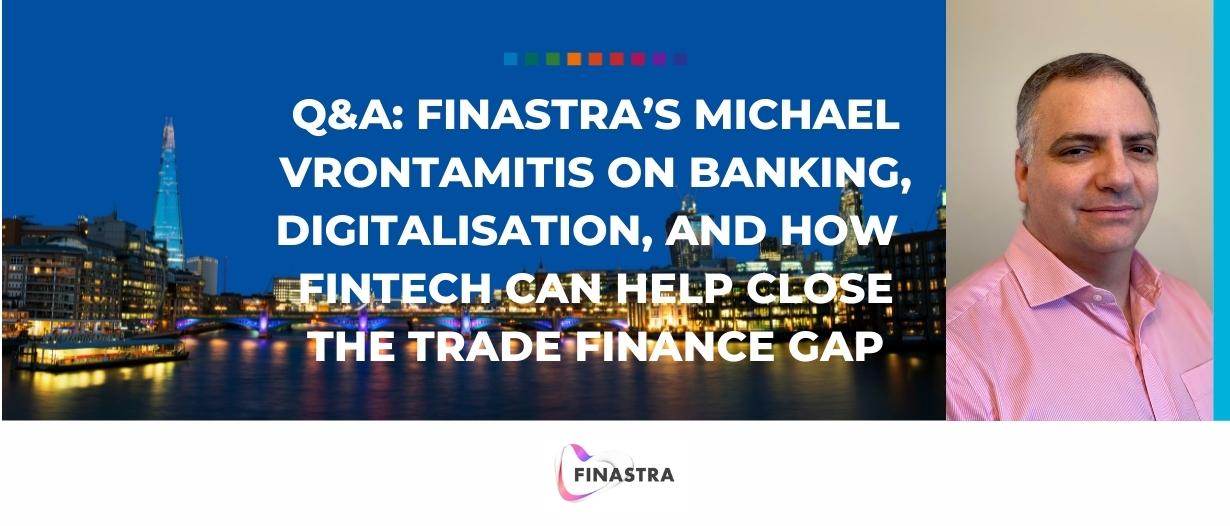In January 2022, Michael Vrontamitis was appointed as the lead industry principal of the lending business unit at Finastra.
TFG was delighted to speak with Vrontamitis about his journey to Finastra, his thoughts on banking and digitalisation during the pandemic, and what Finastra can do to help close the widening trade finance gap.
As an experienced leader in trade finance, can you talk a bit about your history prior to joining Finastra?
I’ve had a 25-year career with Standard Chartered in roles serving corporate, institutional, and retail clients.
I spent the last 12 years focused on transaction banking, leading the product management function across Asia for cash, trade, and securities services, and helping to build an enviable position for the bank in CNH before becoming the global head of trade products there.
In the past few years, I ran the business end-to-end, across Europe and America, before taking a career break where I spent time with my family and pursued some of my passions, like golf and advising cool startups.
How has the pandemic changed business lending?
The pandemic has accelerated a number of trends and issues. In particular:
- Automation and digital signatures – banks are looking to improve their core infrastructure, consolidate their lending platforms, and automate their process flows
- Increased focus on risk management as the pandemic revealed weaknesses in lending practices, many of which hit the headlines
- Increased focus on “green” finance and sustainable supply chains
Don't miss out on the different ways your #Lending system could evolve for the better!
— Finastra (@FinastraFS) February 11, 2022
???? Sign up for an exclusive conversation with @aio_identity this February 16th!#Digitization #Automation #Banking #CreditUnion
As trade recovers, are banks stepping up once again to help businesses finance trade?
In general, yes. Some banks have been burned by commodity defaults, and so have reduced exposure to trade, and others are refocusing on trade given the change in interest rate environment and lower than expected defaults through the crisis.
How are banks reacting to these market changes?
After a good year for trade finance banks in 2021, many are investing in updating their core platforms and connecting to the ever-evolving trade finance ecosystem, as corporate clients are also investing in automation of their processes.
With many new offerings in the market, banks are having to make trade-offs on how they engage, given the cost of maintaining so many corporate connections.
Where do you see the future of trade digitalisation heading, and what role can fintechs play?
We are still seeing a plethora of new digital islands being created, as more countries improve their legal systems for digital trade in line with the United Nations’ Model Law on Electronic Transferable Records (MLETR).
There are still far too few bridges that connect them, however. The work being done by the standards bodies is critical to building these bridges, but it will take time.
We will continue to see some great solutions leveraging some of the latest technologies such as cloud, blockchain, and machine learning to help solve specific problems in the trade finance space.
But full realisation of this potential is some way off, unless we see the advent of a digital connector or network of networks.
Finastra is uniquely positioned as an orchestrator of ecosystems to help banks connect to fintechs and access innovation at speed, through its open banking mindset and open development platform, FusionFabric.cloud.
???? In our recent poll, 55% of you voted cloud & system security as the biggest concern when it comes to cloud adoption.
— Finastra (@FinastraFS) January 17, 2022
???? Read our blog, which helps debunk the five biggest myths surrounding cloud security! #Lending #Fintech #CloudSecurity
What are fintechs like Finastra doing to address the widening trade finance gap?
Technology companies like Finastra play a critical role in providing the underlying technologies and connectivity to enable increased lending into the SME space in a safe and secure way.
For example, there are great fintechs out there originating SME trade finance transactions; however, their access to banks and capital markets can be restricted.
I’m excited that Finastra has partnered with the International Chamber of Commerce (ICC) to develop ICC TradeComm which aims to help to solve this problem by connecting funders and SME originators.
It is a really important step in taking tangible action to solve the trade finance gap.
Closing a $1.5 trillion trade finance gap isn't easy, but hey, you have to start somewhere. We chose Ecuador.
— International Chamber of Commerce (@iccwbo) September 2, 2021
Pilot details: https://t.co/B4QrZv4PT1@FinastraFS @ICC_Ec pic.twitter.com/NldW0khnvD
What are you most looking forward to in your new role at Finastra?
The intersection between trade (and banking) with technology and sustainability has always been a passion of mine.
Finastra has a wide customer base and a great breadth of products, and with the company’s ability to orchestrate ecosystems and open banking solutions, I’m excited about what’s to come.
I look forward to collaborating with our customers and partners, and ultimately working on solutions that can have a positive impact on communities and businesses.
What’s on the horizon for you in the next 6-12 months?
I am looking forward to engaging with the team, our customers and partners, and getting stuck in.





























